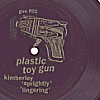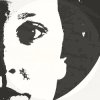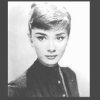Fabulous Failure
| |
 | Reading through some of the more recent Tangents articles, and indeed leafing through the racks of the local record stores, it's easy to think that pretty much everything that can be unearthed, shaken down and given a CD reissue has been through just that process. You might think that the archivists, the obsessive Pop historians have trawled the depths of the underground and left no more than scraps to pick over. It might be the case, but somehow I doubt it. How many of us have the vague but strangely keen half memories of songs heard once or twice on late night radio, never discovered in the record stores of our towns, and now possibly lost forever. I know it's true, because I have those songs, I have those memories. There are even complete labels whose output is still lurking undiscovered, forgotten in the mists of time and adolescent hazes. I was reminded of one of these labels from the mid '80s by a song on the recent excellent Bomb Pops compilation on the marvellous Grimsey label. The Bomb Pops were from Minneapolis, made great music between 1992 and '94 and probably had strange ideas of their own when they wrote 'Plastic Toy Gun' and that whatever those ideas were, I'm sure they were probably completely oblivious to the fact that nearly a decade earlier, a gang of strange Scottish Pop deviants were releasing peculiar records on a label with just that name. Plastic Toy Gun hailed from the west coast of Scotland and was one of many tiny labels to spring from the post-punk scene. Its obvious forebears might have been the ubiquitous Postcard of Glasgow, Fast of Edinburgh and Factory of Manchester, and its heartier brethren might have been Creation, but Plastic Toy Gun left more than enough great Pop mementoes to hold close to a heart that beat to the tune of Art Beat Noise. The obvious reference points were of course Postcard, with their elusive artisan attitudes and their hefty winks towards the Pop Art world of Warhol and the New York school. Indeed, the face behind Plastic Toy Gun, the reclusive Paul Reilly, would make regular trips to Glasgow to see Orange Juice and Josef K perform, notoriously wore silver wigs to school and was noted for saying on more than one occasion that he only wanted to release one record as good as 'Little Johnny Jewel' and then die. High standards and great ambitions, and for sixteen year olds from the sticks that was doubly daring. Reilly had been making music with some of his scholastic outcasts since 1980, when he was 14, and by 1984 they had coalesced into a group who made noise to escape the world, Pop to invent escape routes. One day in May 1984 they entered the school playground with spray paint on the backs of their purple blazers. The paint said, simply, 'Kimberley'. |
 | Kimberley naturally took their name from the Patti Smith song and made peculiar, scratchy and subdued noise. They sounded like the electro pulse of Suicide attempting to mate with Felt. Andrew Blackwood, who always seemed to wear a deeply furrowed brow, was the Kimberley electrician, creating strange boxes that emitted alien belches and squawks. On top of these a simple drum machine spat basic rhythms whilst Neil Macinnon and Reilly sculpted rudimentary guitar washes and proffered obtuse poetics in mumbled tones. Their earliest shows, at the Plastic Toy Gun 'club' the aptly and literally named 'Andy's Garage' were chaotic affairs and like all the greatest Pop events were completely mythic in their stature. Of course, Kimberley and the Plastic Toy Gun gang were ridiculed by most of their peers, but that was just fine, that was just the way of great Pop and if you cared about such things then such isolation was success. Thinking that it was just small town blinkers that made them so detached, however, the group tried to drop into the tight-knit Glasgow Scene but were largely ridiculed for being 'too Middle Class'. Which was rich coming from people who rooted their alleged Punk Rock revolutionary stances in the likes of Belshill. So of course like all the greatest Pop outsiders they made their own scene and feverishly went about the teenage business of intense invention and reinvention. |
 | 'Andy's Garage' had started in the Spring of 1984, and by the height of summer events were being held almost weekly in the large shell of a double garage in the forlorn village of Dundonald. Although the clientele consisted mainly of the peculiar outsiders from school, there would be occasional visits from gangs from neighbouring towns who had heard rumours of the vibe being created in the wilds. Kilmarnock was a short bus trip inland; Irvine an equally brief ride north, and Ayr a slightly longer trail south. From here came disillusioned kids out to hear their favourite songs, and to watch the Reilly gang play their quirky noise. Sometimes too these gangs would bring their own instruments, play impromptu sets as bands that sometimes would last for a week, sometimes two, rarely three, although from their ashes grew the cores of groups as strange and diverse as Blam Blam YC (mad ruffians from Ayr who were like early Fuzzbox playing Fire Engines), The Big Gun (Irvine's finest who played a sublime Postcard pop) and Kilmarnock's Trashcan Sinatras. There was always something new to excite the senses at the Garage. Blackwood was obsessed with electronics and created strange sound generators that would be set off by anyone standing or sitting on pressure pads. Some of these would be connected to old tape decks that would run with dialogue from Apocalypse Now or The Deerhunter, spattering the words over whatever was playing on the record deck. The whole place slowly seemed to decorate itself over the year, with surfaces becoming silver in homage to the Factory, whilst the Reilly family's home movies would run, projected onto the 'stage' (one end of the garage was where the sound equipment was stacked, and this was where the bands played. It was an electrical nightmare, which is probably why Blackwood rarely seemed to leave its confines). Blackwood and Reilly were also notorious skip-rakers, and built up a hefty store of television sets. Between 1982 and 1985 they must have collected nearly 30 sets, all of which Blackwood tweaked until they at least glowed when turned on. Most nights at the Garage in the summer of '84 were accompanied by a wall of these sets, all de-tuned to snow, casting eerie shadows across the floor. For a sixteen year old hell bent on escaping the banality of the world, it seemed like the strangest and greatest place on earth. |
 | Kimberley played most Saturday nights at the Garage in '84. Sometimes they would just crank up the noise and play drones for an hour, other times they would snap into great short melodic blasts of Pop and play for ten minutes. By the end of the summer they had a large pile of tapes and a similarly sized pile of rejection letters from record labels. There was some strange Class Identity thing going on with the whole punk and underground music scene in the '80s. As a reaction against the Thatcherist hyper-capitalism of the era, most of these underground identities were painted in resolute greys peppered with bursts of angry political rhetoric, and there seemed to be an apparently deep rooted mistrust of the Middle Classes, or at the very least of artisan pop-leanings. Such an atmosphere was deathly for Kimberley, who made no secret of their Middle Class backgrounds and who celebrated Art at every opportunity (flyers for their shows at the garage regularly featured details from paintings or images of artists, from obvious to obscure, and slides of Reilly's favourite painters, Rothko and Raushenberg shone spectrally on the silver walls). Not that the lack of interest from anyone much outside of their circle mattered: they had been devouring post-punk culture for some time, and knew from the likes of Postcard and particularly Daniel Treacy's Whaam! label that making records was not the sole domain of large businesses. Similarly, they knew that the music press was not the world, and had been trading tapes with fanzines around the country, getting a steady flow of requests for copies in the process. As a result of this, the three members of the band pooled their savings in August, 'borrowed' some extra cash from Blackwood's cousin and mailed off a tape to Lintone. The first Kimberley flexi looked terrific. The sleeve was a picture that Reilly had found in a book about Weimar art and was obviously in homage to the sleeve of 'Crumbling the Antiseptic Beauty' whilst on the label there was the trademark Plastic Toy Gun (an old print of a plastic raygun that Reilly had found in a comic in Oxfam and which, coincidentally, turned up later on the Baby Lemonade flexi on Sha-La-La) in gold. It sounded great too, with two stabs of their truculent electro-noise-pop in 'Sprightly' and 'Lingering'. Always keen to upset expectations, 'Sprightly' was anything but, being a slo-mo blissed out drone, whilst 'Lingering' stretched out to all of one minute. The 250 copies of the disk were distributed through the usual fanzine network, with a hefty number disappearing into the world with Reilly's own fanzine, the art-centric 'Bright Frantic Symphony'. Within a few months all were gone. |
 | Kimberley kept playing at the Garage through the winter of '84, and though the events were now less than regular, the group honed their insular, paranoid noise to great effect. New songs came through that seemed to be slower than ever, suffused with a deathly melancholic beauty, like Joy Division on Mogadon, and they sounded fantastic. They even managed to insinuate themselves onto the stage at their high school Christmas dance, where they delivered a chaotic show that lasted barely five minutes. In February 1985 Kimberley put out their second flexi, with the looping, loping 'Micron' and a cover of Suicide's 'Dream Baby Dream'. The sleeve used the same picture from the first flexi, this time zooming in on a single eye. It was a ragged and ravishing artefact that again found favour in the fanzine world, whilst gathering nothing but ridicule from bigger labels and the music press, although Alan McGee did write back saying that he thought it was a great name. The Creation connection went further later that year when the Jasmine Minks played at the 101 Lounge in Ayr, one of the shows that the Blam Blam YC team were starting to put on in their town. Blam Blam asked Kimberley to play third on the bill after the Minks and themselves and Reilly initially agreed, but later said no when he found out that they wouldn't be able to bring their projectors. The group nevertheless went to the show, and later Reilly said that it was seeing the Minks play that signalled the end of Kimberley: Reilly was inspired by the edgy funk punk soul drive of the Minks, and wanted to make similar sounds, whilst Blackwood walked away bored and mumbling something about Kraftwerk and Cluster. Kimberley kept it together long enough however to make their only 'real' record, an eponymous 7" collecting three new songs; 'Stitches' was the fastest they had been to date, and gave hints at both the tensions between Blackwood and Reilly and the divergent directions that both wanted to take; 'White' was a minimalist loop affair punctuated by found sound. Best of all was the expansive, expressionist indulgence of 'Rothko', where slabs of guitar did battle with pulses and washes of synthesizer, through which the voice of new recruit Clare Ogilvie wove sparkling threads of melody. |
 | Clare Ogilvie was an Audrey Hepburn obsessive who caught the collective Kimberley eye by walking into the Garage one night in March '85 with a copy of the Marine Girls' 'Beach Party', which she insisted they play all the way through. A year younger than the Kimberley crew, Ogilvie had a voice like an angel, and Reilly became obsessed with getting her to make records with them. Initially unwilling, Ogilvie said the Kimberley sound was too dense and gothic, but after some persuasion agreed to do some vocal dubs on 'Rothko'. It worked brilliantly, although Ogilvie remained unconvinced and insisted on doing something more acoustic and mellow in the future. Although by now Reilly was intent on making beat noise like the Jasmine Minks and Hurrah! he nevertheless retained a love for the acoustic stylings of the Marine Girls and of Tracey Thorn in particular, and soon he and Ogilvie were writing and recording new songs away from Blackwood and Macinnon, who themselves were shaping their own sonic visions. And so it was that almost to coincide with the release of the single, and with barely anyone noticing, Kimberley became history. It's hard to know if any amount of positive press coverage would have made Kimberley get together again, but it's an irrelevance in any case. The NME called it "shoddy sub-Cocteaus meets Cabaret Voltaire made by and for Middle-Class losers" whilst Sounds said that Kimberley were "the ass-end of the underground that needs to get out more. Either that or listen to Sonic Youth". The quotes were copied and projected in the Garage for the rest of '85, not that many people got to see them of course. Despite the music press slating, the single still sold, out of local stores and through the fanzine network, where it was much more warmly received, possibly because mutual-support was the key to survival. It also meant that with orders for the record came demos, tapes that Reilly took to hanging by their innards from the roof of the Garage. They looked great. |
 | Although Kimberley were no longer a group, the three members still wanted to make records, and more than this, remained set on complete control of their art by running the show themselves. Although they differed on musical styles, they were all unified in their rejection of traditional rock routes and their passion for the world of bedroom pop revolution. Blackwood was tinkering with electronics and tape loops, creating oddball experimental noisepop; Macinnon was obsessed with a fifteen year old called Iain McEwan who sported a great red semi-acoustic and smart grey school jumper and who was writing songs about beer, girls, boys and schools. Macinnon was filling the songs out with frantic Subway Sect guitars, and they called themselves Crystal Smile because it sounded like a Primal Scream song title. Strangely, they sounded like profound poetry. Reilly meanwhile was working with Ogilvie on new songs which, reflecting his new obsession with Hemingway, they were recording under the name Brett Ashley. These songs were largely in the acoustic style that Ogilvie insisted on, and Reilly would throw in obtuse Love and Beach Boys references to make things special. All three groups put out singles on Plastic Toy Gun in 1986. First out of the blocks in March were Brett Ashley, whose 'Homecoming' naturally came sleeved in a picture of Audrey Hepburn. 'Homecoming' was a gem that framed Ogilvie's voice in muted red Indian drums and subdued guitar. Imagine the sound of the Shop Assistants at their slow best and you'd be getting close. Naturally, with their impeccable 'Punk Rock' credibility, however, it was those Shop Assistants that gathered all the press and sales, but that's nothing to take anyone to task over per se, of course. |
 | Blackwood's first solo effort followed soon after. The 'Glitch' EP was all mad rhythms and electro blasts that microwaved your brain if you listened to it too much. Meaningless vocal samples rambling about Cuba and cabbages tumbled over the top. It was chaotic and brilliant. The sleeve was great too, with a cut-away drawing of a VW Beetle against an orange background; real Germanic industrial anonymity that suited the sounds to perfection. 'Glitch' was followed by another two Blackwood singles, 'Shattered' in May and 'Aeroflot' in October; both came housed in similarly faceless sleeves, and both were full of similarly bizarre noises and beats. Listening back, they could almost be blueprints for later techno tomfoolery, but that's probably being too kind, and you would need to weigh such a suggestion with the knowledge that Blackwood was a huge Cabaret Voltaire and Thomas Leer fan. Nevertheless, the Blackwood singles more than anything else from Plastic Toy Gun still sound fresh and relevant. July saw the first and only recorded offering from Crystal Smile in the fuzzy 'Miss' 7". Played now it sounds like a generic jangle pop frenzy, but at the time Macinnon's edgy guitar additions for sure lifted it above the murk of other no-hopers like the Darling Buds or Bubblegum Splash. Crystal Smile didn't last long though, with McEwan tiring of Macinnon's attentions, ditching the grey jumpers in favour of black leather and turning to playing Cure covers. July also saw a second Brett Ashley 7", the frankly disappointing 'Eyes, Bleeding' that sounded all muddy and awkward in all the wrong ways, whilst the flip, the aptly titled 'Bubblegum' showed off Ogilvie's growing infatuation with Talulah Gosh. It did not bode well for the future. |
 | It was pretty clear from day one that the label and the bands were going to be transitory Pop events. The appeal of constructing identities within the constraints of the environment they were thrust into was great, and without a doubt, like the best Pop outsiders before and after them, they made a great job of sculpting strange and divergent lifestyles: nevertheless, the pull of the 'real' world was powerful, and the need to move on and up was too strong. So by the end of '86, when the final two Plastic Toy Gun singles appeared, the whole scene was shattered beyond repair. It was a great time to celebrate. The celebration was the third Blackwood single, the aforementioned 'Aeroflot', and the last offering from Brett Ashley. Thankfully, the one-sided Pop artefact that was 'A Year Without Me' erased the memories of the disappointment of the summer record, being full of chiming, soaring guitars and machine gun drum machine rhythms. The record came sleeved once again in an Audrey Hepburn photo, and out of the first 100 copies slid an individual Reilly linoprint of the Toy Gun logo. After this the core of Plastic Toy Gun naturally splintered and moved out across the world, set to blaze their own trails. Some, mirroring Syd Barrett and the elusive and magical Oliver Jackson of the mythic Emily before and after them, seemed to simply drop from view entirely, whilst others continued, in their own peculiar ways, to make strange and affecting art. But that, as they say, is another story entirely, and whether it, like any story of an artistic past is worth telling is for someone else again to decide. For now I can only say that Plastic Toy Gun may have failed to deliver on the dream of a 'Little Johnny Jewel', but for the delights they gave in some faraway important days of teenaged madness and enlightenment, they were a fabulous failure. And if you ask me, all Pop stories should end this wayÉ © Alistair Fitchett 1999 |